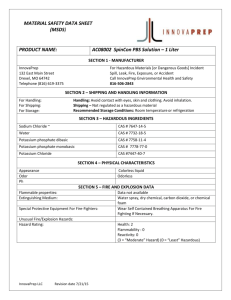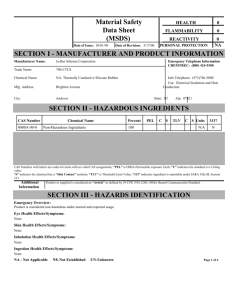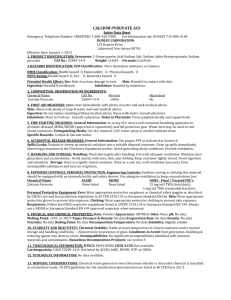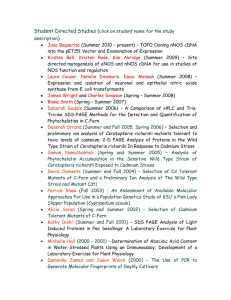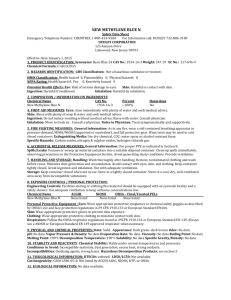Material Safety Data Sheet
advertisement
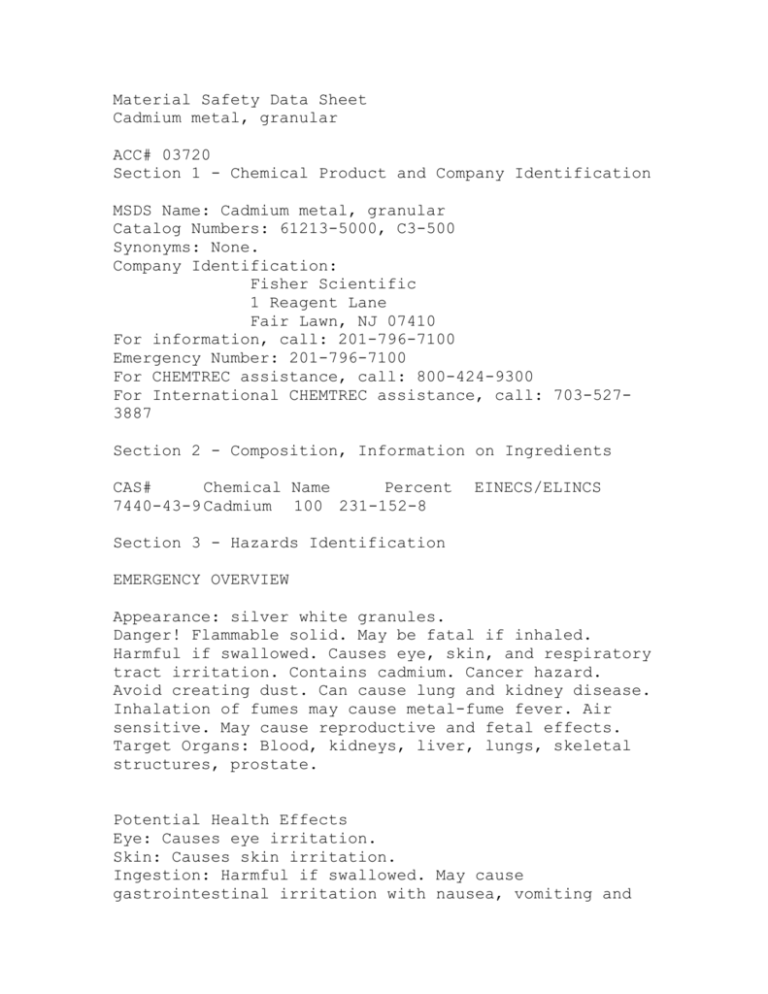
Material Safety Data Sheet Cadmium metal, granular ACC# 03720 Section 1 - Chemical Product and Company Identification MSDS Name: Cadmium metal, granular Catalog Numbers: 61213-5000, C3-500 Synonyms: None. Company Identification: Fisher Scientific 1 Reagent Lane Fair Lawn, NJ 07410 For information, call: 201-796-7100 Emergency Number: 201-796-7100 For CHEMTREC assistance, call: 800-424-9300 For International CHEMTREC assistance, call: 703-5273887 Section 2 - Composition, Information on Ingredients CAS# Chemical Name Percent 7440-43-9 Cadmium 100 231-152-8 EINECS/ELINCS Section 3 - Hazards Identification EMERGENCY OVERVIEW Appearance: silver white granules. Danger! Flammable solid. May be fatal if inhaled. Harmful if swallowed. Causes eye, skin, and respiratory tract irritation. Contains cadmium. Cancer hazard. Avoid creating dust. Can cause lung and kidney disease. Inhalation of fumes may cause metal-fume fever. Air sensitive. May cause reproductive and fetal effects. Target Organs: Blood, kidneys, liver, lungs, skeletal structures, prostate. Potential Health Effects Eye: Causes eye irritation. Skin: Causes skin irritation. Ingestion: Harmful if swallowed. May cause gastrointestinal irritation with nausea, vomiting and diarrhea. Ingestion may produce fluid loss, acute renal failure, and cardiopulmonary depression. Inhalation: May be fatal if inhaled. Inhalation of fumes may cause metal fume fever, which is characterized by flu-like symptoms with metallic taste, fever, chills, cough, weakness, chest pain, muscle pain and increased white blood cell count. Damage may be delayed. May cause nausea, vomiting, abdominal pain, diarrhea, chest tightness, weakness, and delayed pulmonary edema. In humans inhalation causes proteinuria, an excess of protein in the urine. Chronic: May cause respiratory tract cancer. Repeated inhalation may cause chronic bronchitis. Chronic inhalation may cause nasal septum ulceration and perforation. Cadmium and compounds may cause lung, liver and kidney damage and lung and prostate cancer in humans. May cause loss of smell, emphysema, anemia, bone demineralization, and lung fibrosis. The primary target organ for chronic cadmium disease is clearly the kidney. Section 4 - First Aid Measures Eyes: Immediately flush eyes with plenty of water for at least 15 minutes, occasionally lifting the upper and lower eyelids. Get medical aid. Skin: Get medical aid. Flush skin with plenty of water for at least 15 minutes while removing contaminated clothing and shoes. Wash clothing before reuse. Ingestion: Do not induce vomiting. If victim is conscious and alert, give 2-4 cupfuls of milk or water. Never give anything by mouth to an unconscious person. Get medical aid immediately. Inhalation: POISON material. If inhaled, get medical aid immediately. Remove victim to fresh air. If not breathing, give artificial respiration. If breathing is difficult, give oxygen. Attempt rescue only after notifying at least one other person of the emergency and putting into effect established emergency procedures. Do not become a casualty yourself. Notes to Physician: Administration of calcium disodium EDTA may be useful in acute poisoning with its use at the discretion of qualified medical personnel. Persons with kidney disease, chronic respiratory disease, liver disease, or skin disease may be at increased risk from exposure to this substance. Section 5 - Fire Fighting Measures General Information: As in any fire, wear a selfcontained breathing apparatus in pressure-demand, MSHA/NIOSH (approved or equivalent), and full protective gear. Material can spontaneously ignite (pyrophoric) when exposed to air at normal or slightly elevated temperatures. Dust can be an explosion hazard when exposed to heat or flame. Flammable solid. May burn rapidly with flare burning effect. May re-ignite after fire is extinguished. Dangerous fire hazard in the form of dust when exposed to heat or flame. Extinguishing Media: Use dry sand, graphite powder, dry sodium chloride-based extinguishers. Flash Point: Not available. Autoignition Temperature: Not available. Explosion Limits, Lower:Not available. Upper: Not available. NFPA Rating: (estimated) Health: 4; Flammability: 2; Instability: 1 Section 6 - Accidental Release Measures General Information: Use proper personal protective equipment as indicated in Section 8. Spills/Leaks: Vacuum or sweep up material and place into a suitable disposal container. Avoid generating dusty conditions. Remove all sources of ignition. Use a spark-proof tool. Provide ventilation. Place under an inert atmosphere. Section 7 - Handling and Storage Handling: Wash thoroughly after handling. Wash thoroughly after handling. Remove contaminated clothing and wash before reuse. Minimize dust generation and accumulation. Use spark-proof tools and explosion proof equipment. Avoid contact with skin and eyes. Do not breathe dust, mist, or vapor. Empty containers retain product residue, (liquid and/or vapor), and can be dangerous. Keep away from heat, sparks and flame. Do not ingest or inhale. Handle under an inert atmosphere. Store protected from air. Use only in a chemical fume hood. Do not pressurize, cut, weld, braze, solder, drill, grind, or expose empty containers to heat, sparks or open flames. Storage: Keep away from heat and flame. Keep away from sources of ignition. Store in a tightly closed container. Store in a cool, dry, well-ventilated area away from incompatible substances. Do not expose to air. Store under an inert atmosphere. Section 8 - Exposure Controls, Personal Protection Engineering Controls: Use explosion-proof ventilation equipment. Facilities storing or utilizing this material should be equipped with an eyewash facility and a safety shower. Use only under a chemical fume hood. See 29CFR 1910.1027 for regulations applying to all occupational exposures to cadmium and cadmium compounds, in all forms. Exposure Limits Chemical Name ACGIH NIOSH OSHA - Final PELs Cadmium 0.01 mg/m3 TWA; 0.002 mg/m3 TWA (respirable fraction) 9 mg/m3 IDLH (dust) 5 æg/m3 TWA; 0.1 mg/m3 TWA (fume, applies to any operations or sectors for which the Cadmium standard is stayed or otherwise not in effect); 0.2 mg/m3 TWA (dust, applies to any operations or sectors for which the Cadmium standard is stayed or otherwise not in effect); 0.3 mg/m3 Ceiling (fume, applies to any operations or sectors for which the Cadm ium standard is stayed or otherwise not in effect ); 0.6 mg/m3 Ceiling (dust, applies to any operations or sectors for which the Cadmium standard is stayed or otherwise not in effect); 2.5 æg/m3 Action Level; 5 æg/m3 TWA (Do not eat, drink or chew to bacco or gum or apply cosmetics in regulated areas. Carcinogen - dust can cause lung and kidney disease. See 29 CFR 1910.1027) OSHA Vacated PELs: Cadmium: No OSHA Vacated PELs are listed for this chemical. Personal Protective Equipment Eyes: Wear appropriate protective eyeglasses or chemical safety goggles as described by OSHA's eye and face protection regulations in 29 CFR 1910.133 or European Standard EN166. Skin: Wear appropriate protective gloves to prevent skin exposure. Clothing: Wear appropriate protective clothing to prevent skin exposure. Respirators: A respiratory protection program that meets OSHA's 29 CFR 1910.134 and ANSI Z88.2 requirements or European Standard EN 149 must be followed whenever workplace conditions warrant respirator use. Section 9 - Physical and Chemical Properties Physical State: Granules Appearance: silver white Odor: odorless pH: Not available. Vapor Pressure: Not applicable. Vapor Density: Not available. Evaporation Rate:Not applicable. Viscosity: Not applicable. Boiling Point: 765 deg C @ 760 mmHg Freezing/Melting Point:321 deg C Decomposition Temperature:Not available. Solubility: Insoluble. Specific Gravity/Density:8.64 @ 25°C Molecular Formula:Cd Molecular Weight:112.40 Section 10 - Stability and Reactivity Chemical Stability: Oxidizes when exposed to air. Easily tarnishes in moist air. Powder or liquid is pyrophoric. Contact with acid liberates gas. Conditions to Avoid: Ignition sources, dust generation, excess heat, prolonged exposure to air. Incompatibilities with Other Materials: Strong oxidizing agents, acids, sulfur, zinc, selenium, tellurium. Hazardous Decomposition Products: Toxic cadmium oxide fumes. Hazardous Polymerization: Has not been reported. Section 11 - Toxicological Information RTECS#: CAS# 7440-43-9: EU9800000 LD50/LC50: CAS# 7440-43-9: Inhalation, rat: LC50 = 25 mg/m3/30M; Oral, mouse: LD50 = 890 mg/kg; Oral, rat: LD50 = 2330 mg/kg; . Carcinogenicity: CAS# 7440-43-9: * * * * ACGIH: A2 - Suspected Human Carcinogen California: carcinogen, initial date 10/1/87 NTP: Known carcinogen IARC: Group 1 carcinogen Epidemiology: Occupational exposure to cadmium has been implicated in a significant increase in prostate and respiratory tract cancer. There is evidence of a significant excess of respiratory cancer deaths among a cohort of cadmium production workers, and concluded that cadmium and its compounds are potential carcinogens. Teratogenicity: Oral, rat: TDLo = 155 mg/kg (male 13 week(s) pre-mating and female 13 week(s) pre-mating - 3 week(s) after conception) Effects on Newborn - growth statistics (e.g.%, reduced weight gain) and Effects on Newborn - behavioral.; Oral, rat: TDLo = 23 mg/kg (female 1-22 day(s) after conception) Specific Developmental Abnormalities - blood and lymphatic systems (including spleen and marrow).; Oral, mouse: TDLo = 1700 mg/kg (female 8-12 day(s) after conception) Effects on Newborn - viability index (e.g., # alive at day 4 per # born alive) and Effects on Newborn - growth statis Reproductive Effects: Oral, rat: TDLo = 21500 ug/kg (multigenerations) Fertility - pre-implantation mortality (e.g. reduction in number of implants per female; total number of implants per corpora lutea).; Intraperitoneal, rat: TDLo = 1124 ug/kg (male 1 day(s) pre-mating) Paternal Effects - spermatogenesis (incl. genetic material, sperm morphology, motility, and count). Mutagenicity: Micronucleus Test: Mouse, Embryo = 6 umol/L.; Cytogenetic Analysis: Hamster, Ovary = 1 umol/L. Neurotoxicity: No information found Other Studies: Section 12 - Ecological Information Ecotoxicity: Fish: Rainbow trout: TLm = 30 ppm; 24 Hr; Hard waterFish: Striped bass: LC50 = 0.001 ppm; 24-48 Hr; Static bioassayFish: Fathead Minnow: TL50 = 7.2 ppm; 96 Hr; UnspecifiedFish: Bluegill/Sunfish: LCO = 0.08 ppm; 96 Hr; Static bioassay (Hard water) No data available. Environmental: Cadmium can enter the air from natural sources. Physical: No information available. Other: No information available. Section 13 - Disposal Considerations Chemical waste generators must determine whether a discarded chemical is classified as a hazardous waste. US EPA guidelines for the classification determination are listed in 40 CFR Parts 261.3. Additionally, waste generators must consult state and local hazardous waste regulations to ensure complete and accurate classification. RCRA P-Series: None listed. RCRA U-Series: None listed. Section 14 - Transport Information US DOT Canada TDG Shipping Name: TOXIC SOLIDS, FLAMMABLE, ORGANIC, N.O.S. Toxic Solid, Flammable, Organic, N.O.S. (CADMIUM METAL) Hazard Class: 6.1 6.1 UN Number: UN2930 UN2930 Packing Group: I I Section 15 - Regulatory Information US FEDERAL TSCA CAS# 7440-43-9 is listed on the TSCA inventory. Health & Safety Reporting List None of the chemicals are on the Health & Safety Reporting List. Chemical Test Rules None of the chemicals in this product are under a Chemical Test Rule. Section 12b None of the chemicals are listed under TSCA Section 12b. TSCA Significant New Use Rule None of the chemicals in this material have a SNUR under TSCA. CERCLA Hazardous Substances and corresponding RQs CAS# 7440-43-9: 10 lb final RQ (no reporting of releases of this hazardous substance is required SARA Section 302 Extremely Hazardous Substances None of the chemicals in this product have a TPQ. SARA Codes CAS # 7440-43-9: immediate, delayed, fire. Section 313 This material contains Cadmium (CAS# 7440-43-9, 100%),which is subject to the reporting requirements of Section 313 of SARA Title III and 40 CFR Part 373. Clean Air Act: CAS# 7440-43-9 (listed as Cadmium compounds) is listed as a hazardous air pollutant (HAP). This material does not contain any Class 1 Ozone depletors. This material does not contain any Class 2 Ozone depletors. Clean Water Act: None of the chemicals in this product are listed as Hazardous Substances under the CWA. CAS# 744043-9 is listed as a Priority Pollutant under the Clean Water Act. CAS# 7440-43-9 is listed as a Toxic Pollutant under the Clean Water Act. OSHA: None of the chemicals in this product are considered highly hazardous by OSHA. STATE CAS# 7440-43-9 can be found on the following state right to know lists: California, New Jersey, Pennsylvania, Minnesota, Massachusetts. California Prop 65 The following statement(s) is(are) made in order to comply with the California Safe Drinking Water Act: WARNING: This product contains Cadmium, a chemical known to the state of California to cause cancer. WARNING: This product contains Cadmium, a chemical known to the state of California to cause male reproductive toxicity. California No Significant Risk Level: CAS# 7440-43-9: 0.05 æg/day NSRL (inhalation) European/International Regulations European Labeling in Accordance with EC Directives Hazard Symbols: T+ F Risk Phrases: R 11 Highly flammable. R 25 Toxic if swallowed. R 26 Very toxic by inhalation. R 45 May cause cancer. Safety Phrases: S 36/37/39 Wear suitable protective clothing, gloves and eye/face pr otection. S 45 In case of accident or if you feel unwell, seek medical advice immediately (show the label where possible). S 53 Avoid exposure - obtain special instructions before use. WGK (Water Danger/Protection) CAS# 7440-43-9: No information available. Canada - DSL/NDSL CAS# 7440-43-9 is listed on Canada's DSL List. Canada - WHMIS This product has a WHMIS classification of D1A, B4. This product has been classified in accordance with the hazard criteria of the Controlled Products Regulations and the MSDS contains all of the information required by those regulations. Canadian Ingredient Disclosure List CAS# 7440-43-9 is listed on the Canadian Ingredient Disclosure List. Section 16 - Additional Information MSDS Creation Date: 6/28/1999 Revision #7 Date: 2/13/2008 The information above is believed to be accurate and represents the best information currently available to us. However, we make no warranty of merchantability or any other warranty, express or implied, with respect to such information, and we assume no liability resulting from its use. Users should make their own investigations to determine the suitability of the information for their particular purposes. In no event shall Fisher be liable for any claims, losses, or damages of any third party or for lost profits or any special, indirect, incidental, consequential or exemplary damages, howsoever arising, even if Fisher has been advised of the possibility of such damages.


